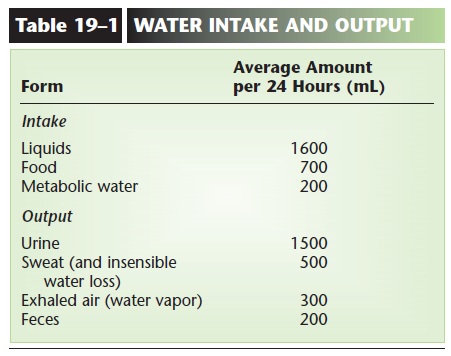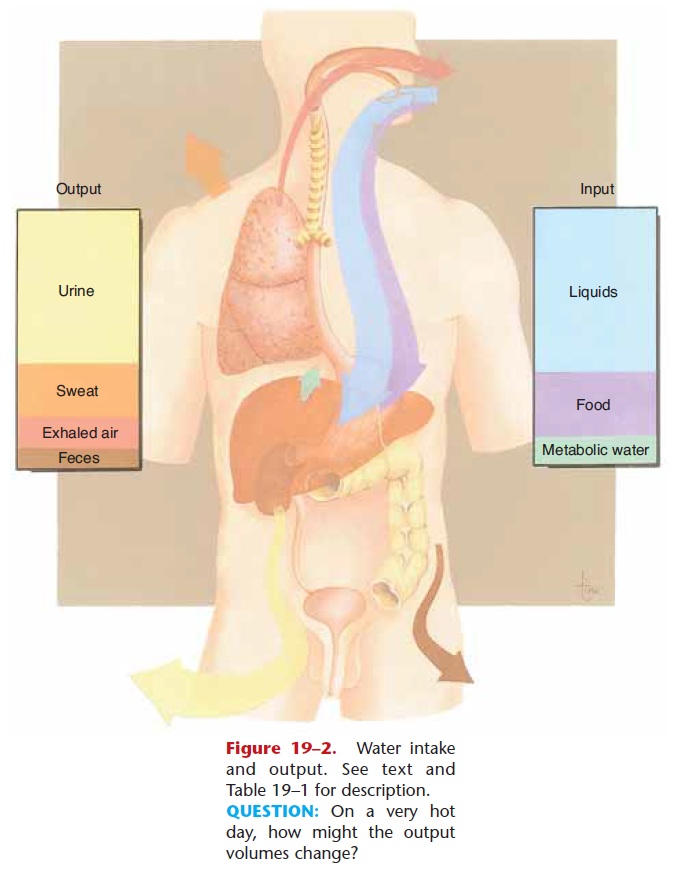Chapter: Essentials of Anatomy and Physiology: Fluid-Electrolyte and Acid-Base Balance
Water Intake and Output in Human body
WATER INTAKE AND OUTPUT
Most of the water the body requires comes from the ingestion of liquids; this amount averages 1600 mL per day. The food we eat also contains water. Even foods we think of as somewhat dry, such as bread, contain significant amounts of water. The daily water total from food averages 700 mL. The last source of water, about 200 mL per day, is the metabolic water that is a product of cell respiration. The total intake of water per day, therefore, is about 2500 mL, or 2.5 liters.
Most of the water lost from the body is in the form of urine produced by the kidneys; this averages 1500 mL per day. About 500 mL per day is lost in the form of sweat, another 300 mL per day is in the form of water vapor in exhaled air, and another 200 mL per day is lost in feces. The total output of water is thus about 2500 mL per day.

Naturally, any increase in water output must be compensated for by an increase in intake. Someone who exercises strenuously, for example, may lose 1 to 2 liters of water in sweat and must replace that water by drinking more fluids. In a healthy individual, water intake equals water output, even though the amounts of each may vary greatly from the averages just men-tioned (Fig. 19–2 and Table 19–1).

Figure 19–2. Water intake and output. See text and Table 19–1 for description.
QUESTION: On a very hot Food day, how might the output volumes change?
REGULATION OF WATER INTAKE AND OUTPUT
The hypothalamus in the brain contains osmorecep-tors that detect changes in the osmolarity of body fluids. Osmolarity is the concentration of dissolved materials present in a fluid. Dehydration raises the osmolarity of the blood; that is, there is less water in proportion to the amount of dissolved materials. Another way to express this is to simply say that the blood is now a more concentrated solution. When dehydrated, we feel the sensation of thirst, character-ized by dryness of the mouth and throat, as less saliva is produced. Thirst is an uncomfortable sensation, and we drink fluids to relieve it. The water we drink is readily absorbed by the mucosa of the stomach and small intestine and has the effect of decreasing the osmolarity of the blood. In other words, we can say that the water we just drank is causing the blood to become a more dilute solution, and, as the serum osmolarity returns to normal, the sensation of thirst diminishes.
As you may recall, the hypothalamus is also involved in water balance because of its production of antidiuretic hormone (ADH), which is stored in the posterior pituitary gland. In a state of dehydration, the hypothalamus stimulates the release of ADH from the posterior pituitary. Antidiuretic hormone then increases the reabsorption of water by the kidney tubules. Water is returned to the blood to preserve blood volume, and urinary output decreases.
The hormone aldosterone, from the adrenal cortex, also helps regulate water output. Aldosterone in-creases the reabsorption of Na+ions by the kidney tubules, and water from the renal filtrate follows the Na+ ions back to the blood. Aldosterone is secreted when the Na+ ion concentration of the blood de-creases or whenever there is a significant decrease in blood pressure (the renin-angiotensin mechanism).
Several other factors may also contribute to water loss. These include excessive sweating, hemorrhage, diarrhea or vomiting, severe burns, and fever. In these circumstances, the kidneys will conserve water, but water must also be replaced by increased consump-tion. Following hemorrhage or during certain disease states, fluids may also be replaced by intravenous administration.
A less common occurrence is that of too much water in the body. This may happen following over-consumption of fluids. The osmolarity of the blood decreases, and there is too much water in proportion to electrolytes (or, the blood is too dilute). This con-dition may become symptomatic, and is called water intoxication. Symptoms are dizziness, abdominal cramps, nausea, and lethargy. Convulsions are possible in severe cases, and fluids must be restricted until the kidneys can excrete the excess water. A hormone that will contribute to that is atrial natriuretic peptide (ANP), which is secreted by the atria when blood vol-ume or blood pressure increases. ANP then decreases the reabsorption of Na+ ions by the kidneys, which increases urinary output of sodium and water. Also, secretion of ADH will diminish, which will contribute to a greater urinary output that will return the blood osmolarity to normal.
Related Topics